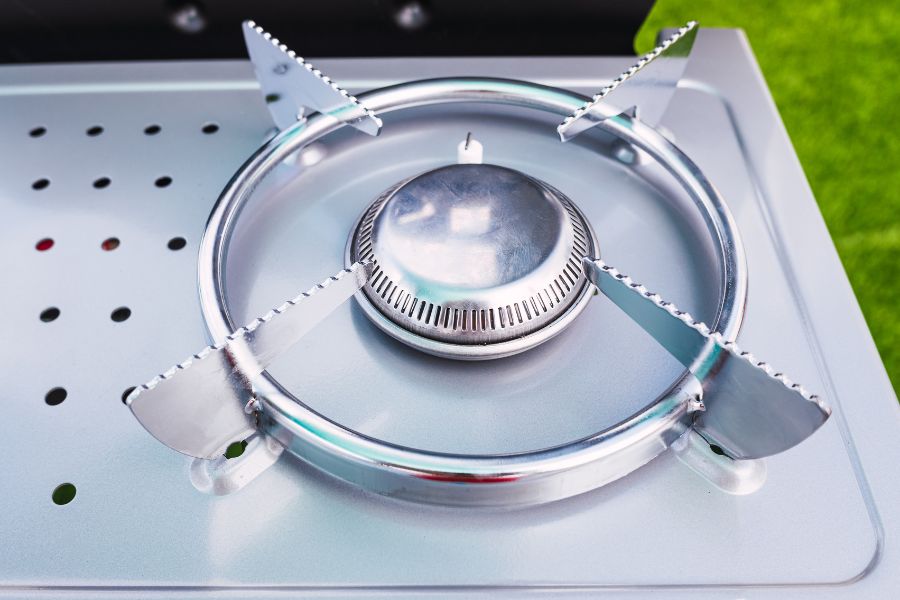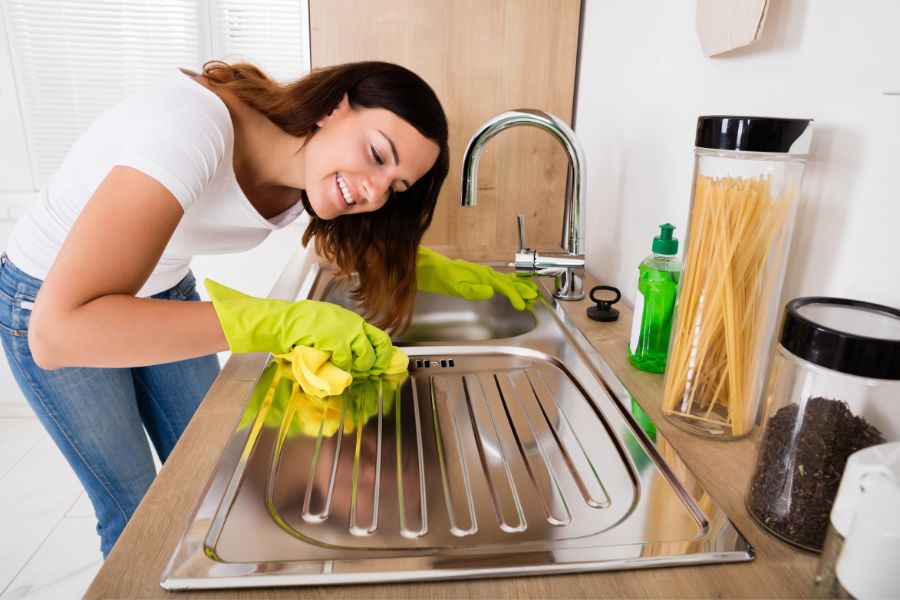Keeping Your Cooktop Sparkling Clean – How to Clean Stainless Steel Cooktop

Cleaning stainless steel cooktops is essential to kitchen maintenance. Not only does it keep your stainless steel stovelooking its best, but it also ensures it operates safely and efficiently. Understanding how to clean stainless steel cooktops is crucial, as these appliances are a staple in modern kitchens due to their sleek appearance and durability. However, stainless steel surfaces will quickly become smudged or stained without proper care, detracting from their appeal. That’s why you need this guide. It will provide detailed steps and tips on maintaining the pristine condition of your stainless steel cooktop. That way, it will remain a shining centerpiece in your kitchen.
If you want to improve your house’s curb appeal, read our guides on outdoor lighting and why you need solar frames. Back to the crux of this post, let’s make you a pro at maintaining your stainless steel cooktops.
Step 1 – Preparation for Cleaning
Before cleaning your stainless steel cooktop, you need to gather supplies and take preliminary steps to ensure safety and effectiveness.
Supplies Needed
- Soft Cloths: To avoid scratching the surface, use microfiber or other soft cloths.
- Non-Abrasive Cleaner: Specialized stainless steel cleaners — you can also use a mild dish soap.
- Baking Soda: This is useful for dealing with tough stains.
- Vinegar: Ideal for natural, streak-free cleaning.
- Warm Water: Helps in loosening grime and residue.
- Rubber Gloves: To protect your hands from cleaning solutions.
- Soft-Bristle Brush or Old Toothbrush: For scrubbing without scratching.
Preliminary Steps
- Ensure the Cooktop is Cool: Never clean a hot surface to avoid burns or thermal shock to the stainless steel.
- Remove Any Removable Parts: This includes grates and knobs, which should be cleaned separately.
- Wipe Down the Surface: A damp cloth removes loose debris and surface grime.
Daily Cleaning Routine
Establish a daily cleaning routine to maintain the appearance and functionality of your stainless steel cooktop. This doesn’t need to be intensive but should be enough to keep up with everyday use. Let’s discuss how to clean stainless steel cooktop daily.
Steps for Daily Cleaning
- Light Wipe: After each use, once the cooktop is cool, wipe it with a soft, damp cloth to remove spills or splatters.
- Apply Cleaning Solution: Mix a small amount of mild dish soap with warm water or use a dedicated stainless steel cleaner. Dampen a cloth with this solution and wipe the surface of the cooktop.
- Tackle Tough Spots: Create a baking soda and water paste for harder-to-remove residues. Apply this gently on the stain and let it sit for a few minutes before wiping it away.
- Rinse Thoroughly: Use a clean, damp cloth to remove any remaining cleaning solution or baking soda paste.
- Dry and Buff: Finally, dry the cooktop with a clean cloth. This step avoids water spots and gives the stainless steel a nice shine.
Tips
- Always wipe in the direction of the stainless steel grain to avoid scratches.
- For daily spills, a quick wipe with a damp cloth and mild soap is usually sufficient.
- Avoid using abrasive sponges or steel wool, as they scratch stainless steel surfaces.
- Regular maintenance prevents the buildup of grease and grime, making deeper cleaning less frequent and easier.
Deep Cleaning Methods
Deep cleaning stainless steel appliances, especially the cooktop, is essential to tackle tough stains and burnt residues accumulating over time. This section will guide you through thoroughly cleaning stainless steel cooktops.
Steps for Deep Cleaning
- Create a Cleaning Paste: Mix baking soda with water to form a paste for stubborn stains on your stainless steel stove top. This paste is gentle yet effective for deep cleaning.
- Apply the Paste: Spread the paste over the stained areas and let it sit for 10-15 minutes. This allows the baking soda to break down the residue.
- Gentle Scrubbing: Use a soft-bristle brush (avoid steel brushes) or an old toothbrush to scrub the area gently. Be sure to go with the grain of the stainless steel surface.
- Use a Specialized Cleaner: For a more thorough clean, apply a commercial stainless steel cleaner like Weiman Stainless Steel Cleaner. These cleaners typically deal with tougher stains on stainless steel appliances.
- Rinse and Wipe: Rinse the area with a damp microfiber cloth to remove the cleaning residue. It’s vital to ensure all cleaning agents are fully removed.
- Treat Burnt-on Residues: For a gas stove, remove and treat the grates separately. Soak them in soapy water and use the baking soda paste for tough spots.

Additional Tips
- Always test a small, inconspicuous area first when using new cleaning products.
- Do not use acidic cleaners or vinegar directly on the stainless steel surface, as vinegar can damage stainless steel if left for too long.
- Avoid using harsh scouring pads, which can scratch the surface.
Preventing Scratches and Damage
Maintaining the integrity of your stainless steel appliance’s surface is crucial. Here’s how to prevent scratches and damage:
Protective Measures
- Use the Right Cleaning Tools: Always use a soft cloth, microfiber cleaning cloth, or paper towel for cleaning. Avoid abrasive tools.
- Proper Cleaning Techniques: Wipe in the direction of the grain. This not only helps in effective cleaning but also prevents scratches.
- Avoid Harsh Chemicals: Steer clear of bleach and other harsh chemicals as they damage the finish of stainless steel surfaces.
- Regular Maintenance: Regular cleaning prevents the buildup of materials that require harsh scrubbing.
Polishing and Finishing Touches
To give your stainless steel cooktop a showroom-quality finish, polishing is key.
Steps for Polishing
- Choose the Right Polish: Use a product specifically designed for stainless steel, like Weiman Stainless Steel Cleaner and Polish.
- Apply Polish: Using a clean microfiber cloth, apply the polish in small amounts.
- Buff to a Shine: Gently buff the surface with a dry microfiber cloth. Work in the direction of the grain for the best results.
- Final Touches: Examine the appliance for missed spots or streaks, and give a final wipe with a fresh cloth.
Additional Tips
- Use polishing products sparingly – a little goes a long way.
- Regular polishing improves the appearance and adds a protective layer to the stainless steel, reducing future smudges and fingerprints.
Maintenance and Care Tips
Proper maintenance and care are vital to preserving the appearance and longevity of your stainless steel appliance. Let’s check out some tips to keep your stainless steel stovetop looking its best:
- Regular Cleaning: Incorporate cleaning your stainless steel cooktop into your routine. This prevents the buildup of grease and grime.
- Use Appropriate Cleaners: Always use cleaners designated for stainless steel. Harsh chemicals damage the surface.
- Soft Cleaning Tools: Employ soft cloths or microfiber cleaning cloths. Avoid abrasive pads or brushes that can scratch the surface.
- Wipe Spills Promptly: To prevent staining, wipe up spills and splatters as soon as the cooktop is cool enough to clean safely.
- Avoid Chlorine and Bleach: These can corrode stainless steel over time. If these substances come into contact with your stovetop, rinse them immediately.
- Dry After Cleaning: Water spots may mar the surface, so thoroughly dry your stainless steel appliance after cleaning.
- Follow the Manufacturer’s Instructions: Refer to the manual provided with your appliance for specific care guidelines.
Troubleshooting Common Issues
You might encounter some common issues with your stainless steel cooktop, even with meticulous care. How do you address them? The following tips will help.
- Streaks After Cleaning: If streaks remain after cleaning, it’s often due to a cleaner buildup. Rinse with clean water and dry with a clean cloth.
- Scratches on the Surface: Minor scratches can be minimized with a stainless steel scratch removal kit. However, deep scratches may require professional attention.
- Discoloration or Rust Spots: Use a paste of baking soda and water to clean the area gently. Rinse thoroughly and dry.
- Vinegar Damage: If vinegar has been left on the surface and caused damage or dullness from long-time use, a stainless steel cleaner may help restore the shine. Avoid leaving vinegar on the surface in the future. But generally, does vinegar damage stainless steel? No, it doesn’t.
- Burnt Residues: For stubborn burnt-on food, use a non-abrasive cleaner and a soft cloth, applying gentle pressure in the direction of the grain.
In a Nutshell
Maintaining your stainless steel cooktop or cooking utensils generally is not just about preserving its sleek and shiny appearance. It’s also about ensuring its longevity and optimal performance. Following these maintenance and care tips, using appropriate stainless steel cleaners, and promptly addressing common issues, you can keep your stainless steel appliance in top condition. Remember, regular cleaning and proper care are the keys to maintaining your stainless steel stovetop’s aesthetic and functional quality, making it a durable and attractive addition to your kitchen for years to come.
Leave a Reply